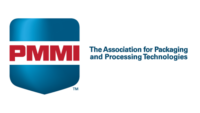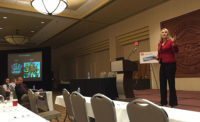Metal detection is a fairly common activity for meat and poultry processors, but more processors are moving away from using metal detection alone and using X-ray systems for broader foreign-object detection.
For example, metal detection and X-ray inspection systems are used in every one of OSI Group’s operations.
“We use them to screen for meat, bones and other foreign objects in raw material — fresh and frozen — ground product, formed product and full cases of finished product,” says Larry Glaser, OSI’s assistant vice president, director of operations support. “We also use X-rays for check weighing, defect elimination and product diameter measuring.”
X-rays and metal detectors are typically used at the end of the process to ensure the safety of the finished product. More recently, manufactures are placing them upstream in the process.
“They are used on meat trimmings prior to the break grind or on frozen blocks,” says Sharon Birkett, OSI’s vice president of North American quality and food protection. “In these two examples, finding the metal before grinding, it saves in many ways. It saves the grinding equipment from getting damaged, it saves downstream equipment from damage and lastly it saves a company from throwing out product that may be contaminated from the metal.”
West Liberty Foods uses a metal detector on every line, and most products are scanned twice to be safe and to limit exposure in processing, says Lee Johnson, the company’s vice president of technical services. West Liberty typically does not use X-ray detection for metal, but does for bone, particularly in chicken products.
“We use X-ray in a couple of different forms looking for bones,” Johnson explains. “We have an inline process that inspects all of our raw materials as we’re receiving them and then we have done some experimenting with piping systems where we have X-rays in pipes that would inspect raw materials as they are coming in.”
With a piping system, product goes through a pipe, which is out of view, and less product is removed if a problematic area occurs, he says.
“A lot of guys like that because you can lose a lot of yield the more it conveys, and it probably saves a little money,” Johnson says.
Furthering detection
OSI has moved toward X-ray systems given their sensitivity and broader detection capabilities; however, Glaser feels some applications still work better with a metal detector.
“We think that in the future we will specify using both to ensure all foreign objects are detected and eliminated,” he says.
Two key components exist to today’s X-ray systems: the generator/detector and the computer processor.
“Both systems are evolving with dual signal/power systems and faster processing speeds,” Glaser says. “The computer algorithms are also getting more sophisticated, providing better analysis of the signal from the X-ray system. In addition to X-ray and metal detectors, you also have the entire range of vision systems, including UV, near infrared, lasers and cameras that are used to identify and provide a signal to remove a foreign object.”
Detecting bone fragments, plastics (hard and flexible), rubber and wood continues to be a challenge. All of the detection systems are identifying foreign objects indirectly, meaning characteristics such as density, conductivity and color are used to assume a foreign object is present. In turn, some defects are missed because of masking the specific foreign object’s characteristic.
Increasing the system’s sensitivity also can create false rejects. Fortunately, the evolution of inspection systems has led to more reliable electronics, faster computer processors, smaller and more sensitive sensors, and more intuitive algorithms, Glaser says.
“Better sensitivity, faster speeds, greater throughputs and multiple capabilities are in the future,” he says. “One area that I hope will evolve in these systems is the data management capabilities of the technology. These systems can count, weigh and measure many dimensions in real time, and with a little help from a control system, broadcast product conditions and data to the operators and managers as the product is being screened. This allows for real-time management and quicker response to process improvement.”
One of the challenges of X-ray is the cost of equipment, but X-ray will continue to come down in costs as the demand increases for the equipment.
“With X-ray, there are some systems right now that can detect much better than others,” says Donna Schaffner, associate director for quality assurance, food safety and training for the Rutgers Food Innovation Center, in Bridgeton, N.J. “They have a more complicated algorithm and screen from different directions, so you are more likely to find something like a piece of wire. That’s something right now that isn’t available except in your most expensive pieces of equipment. The challenge for people building this equipment is to make this more affordable, so it’s not just the high-end equipment, and that it’s readily available for all the price points.”
Another challenge for companies that run various products of different densities through detectors is changing sensitivity settings on instruments and validating that they can actually find foreign objects with the different settings, Schaffner says.
“A lot of times companies don’t really understand that, for example, testing the function on a metal detector is not just a matter of putting the Teflon into the opening with your hand with no product running,” she explains. “It’s not the same as validating in the middle of the product stream that you would still pick up that size piece of metal. Sometimes companies haven’t actually validated that they could find that size piece of metal in all their products … Monitoring, verification and validation are three separate issues, and sometimes companies get those mixed up.”
While technology continues to improve, given the different types of foreign materials, X-ray is not the final solution in detection.
“X-ray is a great addition to the detection family, but is limited by density of the foreign material,” Birkett says. “The best system is to prevent the foreign matter from entering the product stream through diligence in vendor management, process monitoring, preventative maintenance and encouraging open communication so employees feel empowered to speak up when something feels, sounds or looks different.”
Johnson agrees the challenges are people following procedures and attention to detail on the operation floor.
“With a basic good housekeeping preparatory program that prevents all that foreign material actually entering into the product stream, you can eliminate 99.9 percent of it that way,” Johnson says. “Theoretically, you can eliminate all of it that way, and that’s the challenge.”






